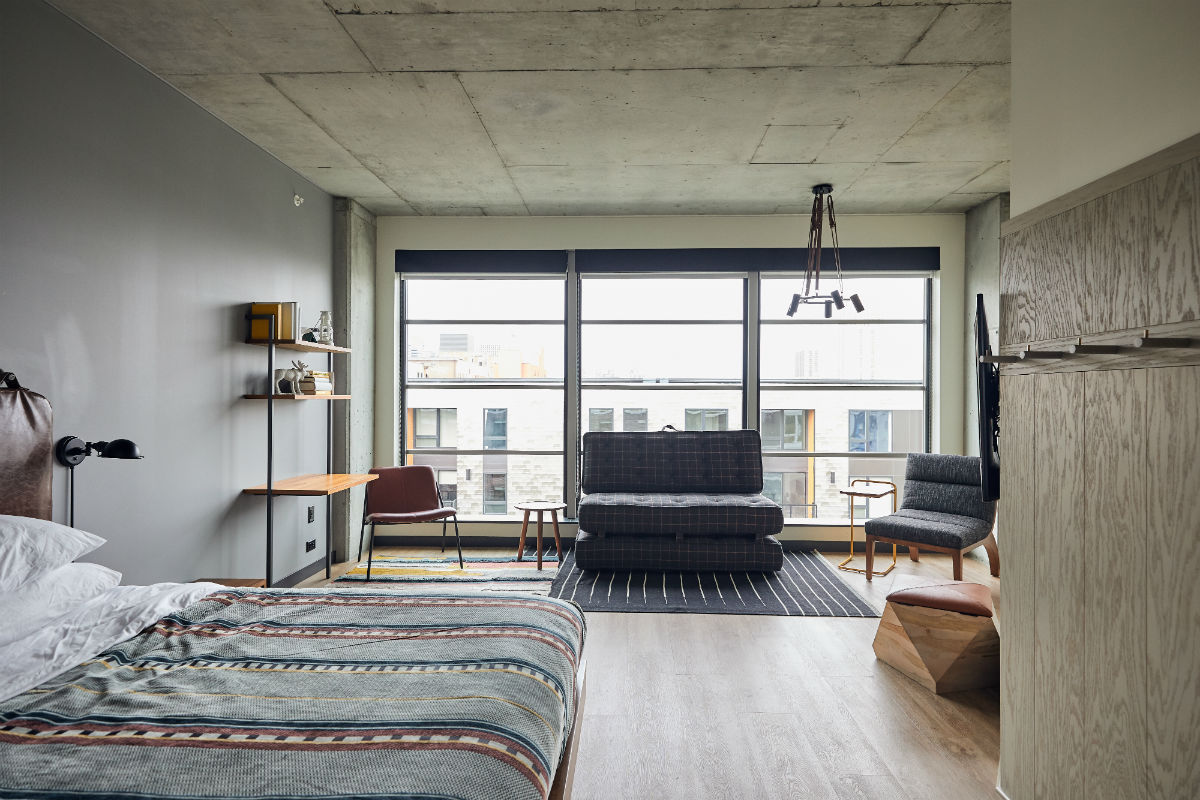At Shea, we pride ourselves on staying on top of what’s happening in design news. It helps us keep tabs on what’s fresh, inspiring, and happening in the world—and we make a few headlines of our own, too. Here are some recent articles delving into design, experience, and what’s buzzing in our community:
“Bed Trends: A Post-Pandemic Insight Into Future Guestrooms” – Hotel Designs:
Hotel Designs examines trends in travel bookings and the adaptation of hotel design to the next generation, focusing on materials, tech, air quality, and sustainability. Replacing traditional soft flooring with tile and stone will come into vogue to ease cleaning between guests, and antimicrobials have become chic. Biophilia has transferred from office to hotel easily, and is part of the sustainable-design movement happening in hotels. Smart technology continues to expand its reach in hotels, with voice activation and single-point controls adding to the existing check-in apps and keyless door entry that are changing the function of the hotel lobby. And ventilation, especially in rooms without operable windows, is key, with open, airy common spaces serving as the standard.
“Taking a Custom Approach to the New Workplace” – Work Design:
As workplaces struggle to find their footing, it’s all about customization of experience for each company. Work Design examines how furniture manufacturers can create pieces that bring both the aesthetic and functionality that employers need, allowing them to explore nontraditional ideas and designs by bringing to life a solution that doesn’t exist. Things like collaborative work pods and tables, room dividers, planters, and outdoor furniture are especially important right now, and going custom is one way that workplaces can get exactly what they need.
“Farmers Kitchen + Bar Brings Market and Café to Former Spoonriver Space” – Shea:
A full roundup of news on the opening of Farmers Kitchen + Bar on the Mississippi River, bringing straight-from-the-farm food to plates
“Polished-Casual Restaurant Concepts Dress Down ‘Stuffy’ Dining Ideas’” – Nation’s Restaurant News:
Polished-casual dining is having a big moment right now, providing high-quality food without the pretension of a traditional fine-dining restaurant. This piece looks at restaurants across the country that have adopted a polished-casual mentality, where guests can feel comfortable dining on expensive cuts of meat, surrounded by chandeliers while wearing their favorite jeans. It’s all about attention to detail, making the experience feel special with high-end ingredients and high-touch service, but not stuffy. Some successful concepts also invoke an element of nostalgia to bring that casual, kid-like mentality into a more formal atmosphere.
“Why Good Design and Empathy are Key to Resuming Office Life Again” – Surface:
Surface takes a look at the shift in attitude toward office work and culture, and its impact on design as employers strive to retain talent. Taking proper precautions to stop the spread of Covid and future variants is one aspect, with designers noting how clients how shifted their allocation of space (rather than reducing square footage) and focusing on practical amenities to help support workers in the office—primarily ones that encourage in-person collaboration. Division of space into different work zones is paramount—with individual spaces for focused work (including workstations equipped with the best video-conferencing tech) and modular furniture for flexibility in working together. The “fun work perks” of the past are less important to employees than creating spaces that engage them when they’re in the office, and surveying employees can help tailor those environments to best serve their—and the companies’—needs.
“Marketers Move into the Future of Retail Design” – Forbes:
In an interview with a Hovercraft Studio executive, Forbes examines the role of marketing strategy in the future of retail design, and its evolution over the past few decades. With direct-to-consumer constantly growing, flagships serve as a sort of brand-discovery center, and need to be a spot that will drive user-generated content as well as sales. With the support of e-commerce, they’re really there to create a purposeful and connected brand experience, with tactile products and a place to give the brand context and storytelling, by way of installations and experiences.
“From Small-Town Boutique Inns to Marriott’s Global Portfolio, Hotels are Getting Covid-Spurred Overhauls” – Business Journal:
The national outpost for the Business Journal dives into how hotels of varying sizes are handling the post-pandemic travel surge, with many having taken advantage of the slowdown to take on capital projects within their spaces. Some of these were accelerations of planned projects, while others have been a direct response to the new focus on health, wellness, and touchless design. Lobbies still function as communal, multi-purpose spaces, with room to work more important than ever with the rise of remote employment. Investing in outdoor space has been key, particularly for boutique hotels, and top-of-the-line tech for everything from check-in to keyless entry to ordering room service and amenities is a must.
“How the ‘New Normal’ is Shaping F&B Operations Design” – CEO World:
With 25% of restaurants in the country either having closed or currently being closed due to the pandemic, CEO World gives insight into restaurants that are surviving the fallout, and the strategies that have worked and will continue to work in the future. From a new sense of space utilization to touchless and serverless dining to the furthering of the “grocerant” trend, they break down nine operational features that have shifted in the past two years, as well as their impacts on the industry and the financial resources it takes to implement them.
“The Copperfield Set to Shine in Mendota Heights” – Shea:
An early look at The Copperfield, the forthcoming Shea-designed all-day restaurant in Mendota Heights
“What the Future Holds for Shuttered Department Stores” – Surface:
With a recent CoreSight Research survey predicting that a quarter of malls will shutter over the next five years, there’s a big question of what will happen with all the empty real-estate space. Even in the years leading up to 2020, many department stores were bowing out of physical locations, with the huge spaces being broken up and leased out to office tenants and smaller retail stores. This is a continued trend, with coworking companies benefitting from the closures as they gain ability to build mini-campuses in the expansive spaces. As many malls are located in the now-hot suburban office markets, shuttered spots seem like key areas for office tenants to focus on as they search for more space, ample parking, and a connection to the outdoors. Other creative uses for such large areas can include event venues, galleries, warehouse space, residential units, and more.
September 1, 2021
Shea Links: September

